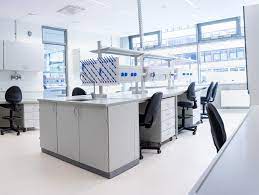Laboratory furniture is designed and constructed to meet the specific needs and requirements of scientific and research laboratories. It plays a crucial role in facilitating efficient and safe laboratory operations. The materials used in the construction of laboratory furniture are carefully selected to ensure durability, resistance to chemicals and abrasion, ease of cleaning, and adherence to safety standards. Here are some common materials used in the manufacturing of laboratory furniture:
-
Steel: Steel is one of the most prevalent materials used in laboratory furniture due to its durability, strength, and resistance to corrosion. It is commonly used for frames, supports, and structural components of laboratory benches, cabinets, and storage units.
-
Chemical-Resistant Laminate: Chemical-resistant laminate is a popular choice for laboratory work surfaces and countertops. It is made by combining layers of melamine resin-impregnated craft paper under high heat and pressure. The resulting material is highly resistant to chemicals, heat, moisture, and abrasion. It is easy to clean and provides a smooth and non-porous work surface.
-
Epoxy Resin: Epoxy resin is a specialized material used for laboratory countertops, sinks, and fume hood liners. It is highly resistant to chemicals, heat, moisture, and staining. Epoxy resin countertops are non-porous, making them easy to clean and maintain. They provide excellent durability and can withstand heavy usage in laboratory environments.
-
Stainless Steel: Stainless steel is widely used in laboratory furniture due to its corrosion resistance and hygienic properties. It is commonly used for sinks, cabinets, and shelves. Stainless steel is easy to clean and maintain, and it provides a sterile and contamination-free environment, making it suitable for medical and biological laboratories.
-
Glass: Glass is utilized in laboratory furniture for applications that require transparency and visibility, such as windows, doors, and viewing panels. Tempered glass is often used for safety reasons, as it is more resistant to breakage and shattering than regular glass.
-
Polypropylene: Polypropylene is a thermoplastic polymer that is resistant to chemicals, acids, and solvents. It is commonly used for laboratory sinks, fume hoods, and storage cabinets. Polypropylene furniture is lightweight, durable, and easy to clean. It is particularly suitable for environments where corrosion resistance and chemical compatibility are essential.
-
Phenolic Resin: Phenolic resin is a composite material composed of layers of phenolic-impregnated paper. It is commonly used for laboratory work surfaces, particularly in educational or research settings. Phenolic resin is resistant to chemicals, heat, and moisture, making it suitable for routine laboratory applications.
-
Wood: While less common in modern laboratory furniture, wood may still be used for aesthetic purposes or in non-hazardous laboratory environments. It is typically coated with chemical-resistant sealants or laminates to enhance durability and resistance to stains and spills.
It's important to note that the selection of materials for laboratory furniture Bahrain may vary depending on the specific requirements of the laboratory, the type of research conducted, and the safety regulations in place. Manufacturers and suppliers of laboratory furniture ensure that their products meet industry standards and guidelines to provide a safe and functional laboratory environment.


No comments yet